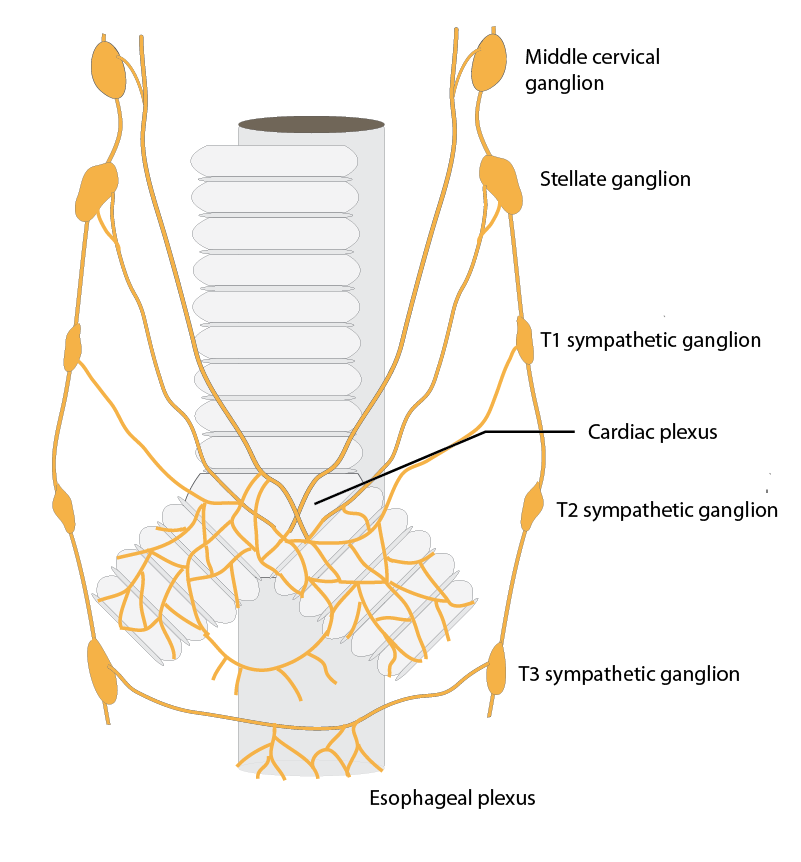WBR1100: Difference between revisions
Jump to navigation
Jump to search
No edit summary |
No edit summary |
||
| Line 23: | Line 23: | ||
|Explanation=The patient in this vignette has a lung adenocarcinoma, located in the apex of the right lung. These apical lung tumors are collectively referred to as pancoast tumors. Because of their location next to the stellate ganglion, these tumors can cause of spectrum of neurological symptoms called Horner’s syndrome. Horner's syndrome is the combination of drooping of the eyelid (ptosis) and constriction of the pupil (miosis) on the same side as the lesion. It is sometimes accompanied by decreased sweating (anhidrosis). | |Explanation=The patient in this vignette has a lung adenocarcinoma, located in the apex of the right lung. These apical lung tumors are collectively referred to as pancoast tumors. Because of their location next to the stellate ganglion, these tumors can cause of spectrum of neurological symptoms called Horner’s syndrome. Horner's syndrome is the combination of drooping of the eyelid (ptosis) and constriction of the pupil (miosis) on the same side as the lesion. It is sometimes accompanied by decreased sweating (anhidrosis). | ||
[[File:Sympathetic_plexuses_2_14_14.png]] | [[File:Sympathetic_plexuses_2_14_14.png | 400px]] | ||
'''Educational Objective:''' Horner syndrome can be caused by a pancoast tumor that impinges on the stellate ganglion. | '''Educational Objective:''' Horner syndrome can be caused by a pancoast tumor that impinges on the stellate ganglion. | ||
Revision as of 20:11, 15 February 2014
| Author | PageAuthor::William J Gibson |
|---|---|
| Exam Type | ExamType::USMLE Step 1 |
| Main Category | MainCategory::Anatomy |
| Sub Category | SubCategory::Neurology, SubCategory::Oncology, SubCategory::Pulmonology |
| Prompt | [[Prompt::A 42-year-old male smoker presents to his primary care physician for excessive sweating on the right side of his face after eating. Three months later, the patient returns complaining of severe pain and tingling in his right arm. The rest of the physical exam is normal except for right-sided ptosis and miosis. Chest x-ray reveals an apical mass. Biopsy of the mass reveals an adenocarcinoma with an EML4-ALK fusion. Which of the following neurological structures is most likely directly disrupted in this disorder?]] |
| Answer A | AnswerA::Right stellate ganglion |
| Answer A Explanation | AnswerAExp::'''Correct:''' This patient has Horner’s syndrome and thoracic outlet syndrome due to an apical lung adenocarcinoma. The symptoms of Horner’s syndrome are caused by compression of the right stellate ganglion. |
| Answer B | AnswerB::Left stellate ganglion |
| Answer B Explanation | AnswerBExp::'''Incorrect:''' Horner’s syndrome causes ipsilateral symptoms, not contralateral. Furthermore, this patient experienced thoracic outlet syndrome due to tumor compression. His symptoms were all on the right side. |
| Answer C | AnswerC::Right ciliary ganglion |
| Answer C Explanation | AnswerCExp::'''Incorrect:''' While Horner’s syndrome causes ocular symptoms, the ciliary ganglion is not directly impinged on by the tumor. |
| Answer D | AnswerD::Left ciliary ganglion |
| Answer D Explanation | AnswerDExp::'''Incorrect:''' While Horner’s syndrome causes ocular symptoms, the ciliary ganglion is not directly impinged on by the tumor. |
| Answer E | AnswerE::Right superior cervical ganglion |
| Answer E Explanation | [[AnswerEExp::Incorrect: While lesions of the right superior cervical ganglion can cause Horner’s syndrome, in this particular case the stellate ganglion is affected. The superior cervical ganglion does not lie in the thorax and is not lesioned due to pancoast tumors. The superior cervical ganglion instead lies adjacent to C2 & C3 in the neck.]] |
| Right Answer | RightAnswer::A |
| Explanation | [[Explanation::The patient in this vignette has a lung adenocarcinoma, located in the apex of the right lung. These apical lung tumors are collectively referred to as pancoast tumors. Because of their location next to the stellate ganglion, these tumors can cause of spectrum of neurological symptoms called Horner’s syndrome. Horner's syndrome is the combination of drooping of the eyelid (ptosis) and constriction of the pupil (miosis) on the same side as the lesion. It is sometimes accompanied by decreased sweating (anhidrosis).
Educational Objective: Horner syndrome can be caused by a pancoast tumor that impinges on the stellate ganglion. References: First Aid 2014 page 610 Friedman JH. Hemifacial gustatory sweating due to Pancoast's tumor. Am J Med. 1987;82(6):1269-71. |
| Approved | Approved::Yes |
| Keyword | WBRKeyword::Ganglion, WBRKeyword::Cancer, WBRKeyword::Tumor, WBRKeyword::Pancoast, WBRKeyword::Lung cancer, WBRKeyword::Horner syndrome, WBRKeyword::Sympathetic, WBRKeyword::Nerve |
| Linked Question | Linked:: |
| Order in Linked Questions | LinkedOrder:: |
